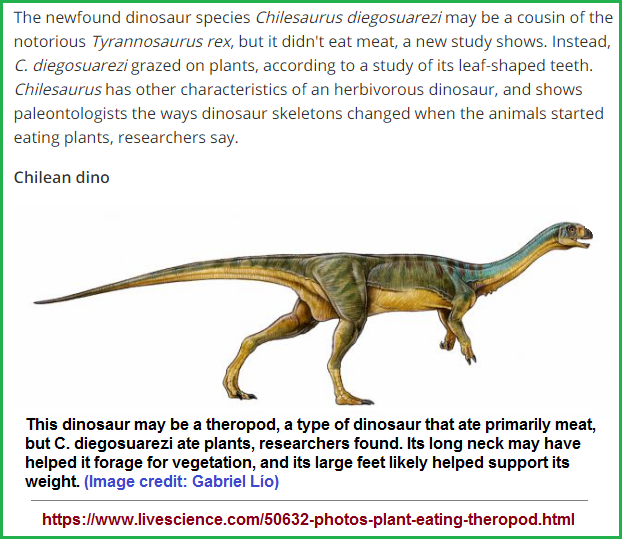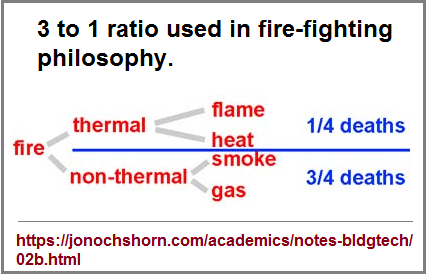Page G
(Study of Threes)
http://threesology.org
Researchers as of 11/20/2019
| 3-to-1 ratios page A | 3-to-1 ratios page B | 3-to-1 ratios page C | 3-to-1 ratios page D |
| 3-to-1 ratios page E | 3-to-1 ratios page F | 3-to-1 ratios page G | Three to One Fundamental Forces |
A relative of Tyrannosaurus rex didn't share the infamous carnivore's appetite for meat, a new study finds. Instead, the newly discovered 9.8-foot-long (3 meters) dinosaur munched on plants about 145 million years ago during the Late Jurassic period.

The new species is a member of the theropod group, which consists of mostly carnivorous dinosaurs and includes not only
T.
rex but also the fearsome Velociraptor.
The study researchers said that the newfound "bizarre herbivorous" creature looked like a (3 in 1) mixture of:
- A plant-grazing, long-necked sauropodomorph;
- An herbivorous beaked ornithischian;
- And a meat-eating theropod.

"When I saw all the fragmented bones laying on the table, I thought all of them belonged to different dinosaur lineages," said the study's lead researcher, Fernando Novas, a researcher at the Bernardino Rivadavia Natural Sciences Museum in Buenos Aires, Argentina. "That dinosaur is spectacular and bizarre because it combines different features belonging to these three main groups of dinosaurs." [See Images of the Bizarre Plant-Eating Dinosaur]
Researchers uncovered the curious fossils in 2010. The observant 7-year-old son of two geologists spotted a few dinosaur vertebrae during an expedition with his family in Aysén, a region in southern Chile. The researchers named the new dinosaur Chilesaurus diegosuarezi, in honor of Chile and the boy, Diego Suárez.
Jung himself noted that often the fourth part of a quaternity appeared somehow different to the other three (smaller, feminine, etc.) [d], using as an example the woman who completes the trinity of men during his trip to Kenya in Memories, Dreams, Reflections. In particular, he points to the fourth element of the Christian quaternity, the Virgin Mary, the chthonic. In the same way that Jung deals with triadic-themed mandalas, so also with dreams.
By Michael Brabazon
In 1838 Edgar Allan Poe published a grim tale called "The Narrative of Arthur Gordon Pym of Nantucket." In it, three survivors of a shipwreck dying of thirst and starvation, kill and eat their companion, Richard Parker, who lost when they drew lots. In 1884 three survivors of a shipwreck were tried for the murder of a fourth. Adrift, and facing starvation, they had killed and eaten their companion, a cabin boy named Richard Parker. (Alan Vaughan, Incredible Coincidence, pp.22-23... item from pages 20-21, Reader's Digest, Mysteries of the Unexplained: How Ordinary men and women have experienced the strange, the uncanny, and the incredible. ISBN 0-89577-146-2, Eleventh printing March 1992)
H.O.B. note: According to the following perspective, we are told that spiritual knowledge is more reliable than knowledge based on reason. Yet, so-called spiritual knowledge typically relies on a series of rationalizations promoted by mood, setting, gender, age, prejudices, race, etc... Each of the so-called four types of knowledge are not referenced with supportive criteria to define them, such as, is knowledge based on reason referring to experimental qualification or simply presumed justification based on the experience of a given person in a given place during a given era?... From where I sit/stand/kneel, spiritual knowledge is in part a product of superstition and may therefore be classed separately from the other three, though it plays a part in most people's lives to some degree, for good or bad... If Plato wasn't impressed with evidence derived from the senses, it may be that during his time the so-called "senses" (however it was interpreted and defined by him), were in a chaotic schizophrenic-type of reality (see theory of Julian Jaynes). The "senses" of Plato's time may have been a type of drunkenness brought on by a wide-spread form of mental illness that he was, in part, aware of and suspicious about.
We find that according to Plato there are four types of knowledge, which from the least to the most reliable is:
- Aesthesis (sense-knowledge)
- Doxa (opinion)
- Episteme (knowledge based on reason)
- Gnosis (spiritual knowledge)
Obviously, Plato wasn't impressed with evidence of the senses. If we look at Eastern philosophy we find either the trilogy (again from least to the most reliable) of Illusion (Parikalpita or Pratibhasika), Empirical (Paratantra or Vyavaharika; this would be Plato's aesthesis and episteme perhaps), and Absolute (Paramartha or Paramarthika, which would seem equivalent to Plato's Gnosis), or at the very least the duality of Relative (Samvriti) and Absolute.
| Plato | Eastern Philosophy | Science | datum of individual experience | explanation | |
| Absolute Knowledge | Gnosis | Paramarthika | n/a | Enlightenment experiences and existence as Absolute Reality | "Finger pointing at the moon" |
| Valid but Relative (Empirical) Knowledge | Episteme / Reason | Paratantra or Vyavaharika | Current Scientific Knowledge | various physical, psychic, and/or spiritual experiences | verified knowledge |
| Illusory Knowledge | Opinion Sense-knowledge |
Parikalpita or Pratibhasika | Falsified theories | n/a* | arbitrary knowledge |
* according to the strict phenomenological premises adopted by Moshe Kroy, every experience is valid. However one could say that the interpretation of that experience may be correct or incorrect.
M. Alan Kezlev, 27 April 2005
Obviously, one can postulate many more than just three levels, in fact one could even say that every metaphysical reality (see following section) has its own form of knowledge that corresponds to it. But to keep things simple we'll keep it at just three. So, it is suggested here that every datum of experience is valid, but an explanation or belief system that is derived first or second or third or tenth hand from such datums, is either (a) illusory, (b) relative but valid, (c) points to the Absolute (the Absolute itself cannot be conveyed in conceptual terms), or (d) a combination of two or all three of the preceding,
Note that I certainly am not saying that hierarchy is all that is. Because the existence of hierarchy automatically assumes its complement/polarity/opposite - equality. A further approach can be had with a trinity of Self, Non-Self, and the Overlap between the two (e.g. Steven Guth's suggestion that the Ego or Conscious Mind is an overlap between the Transcendent Higher Self and the Double) This also is the position of Eastern philosophies like Samkhya and Advaita Vedanta, which refer to the buddhi (Samkhya) or "witness" (Advaita) as the reflection of Pure Consciousness or Self (purusha, atman) upon non-conscious nature (prakriti).
Double in folktales
Bigrams
H.O.B. note: See also... Trigrams are actually Bigrams... page 1
Here only three evolutionary levels are shown - abiotic, biotic, and cultural (corresponding to Matter, Life, and Mind) - but any number of levels can be indicated in this way.
There is a presumed myth (or urban legend) that if you pull out a (one) gray hair and three will grow.

Page Created: Friday, March 21, 2014, 4:40 PM
Updated Posting: Wednesday, 7th July 2021... 1:51 PM